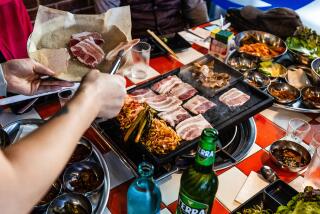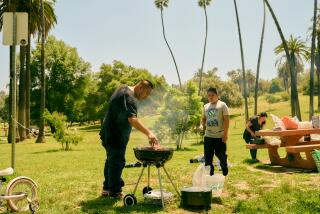Foods We Love : Smokey the Pig
- Share via
While I can claim to have a long-standing affection for barbecue, be that pork ribs or Chinese ducks hanging by their necks in steamy Chinatown windows, or thin-sliced beef brisket, I didn’t truly appreciate the mysteries inherent in good barbecue until I tried to duplicate in my own back yard what I had been eating for years off the hood of the car in a parking lot.
That first confrontation with a Hondo smoker, a big barrel pit born in the Texas oil fields, yielded up barbecued beef tri-tips that tasted, well, off --as though I had taken the meat and rubbed it against the back wall of the fireplace.
There are those who will tell you that the foul lines of a baseball diamond stretch off the field into infinite space. I suspect the learning curve for cooking barbecue is much the same, a high parabola if you will, a pear-shaped, smoke-shrouded rainbow that only rises. In other words, I know I can produce good barbecue from here to my grave and I will never see the downhill side of the curve.
When I say “barbecue,” I mean cooking over low heat, with smoke, for long periods of time. A rack of baby back ribs sits in the pit from four to six hours. A split chicken languishes there for four hours. The well-barbecued beef brisket is something of a marathon event: Plan on 18 hours for a tender result. Time and patience are key elements of good barbecue, and when they are applied with a liberal mopping the results extend well beyond the sublime. When I bring the platter of ribs and sausage to the table, I know I haven’t simply cooked good food, I have truly accomplished something. The guests pause and salivate, as guests have paused and salivated over barbecue since the time before history was recorded.
Debate goes back and forth over the origins of barbecue. Etymologists study the word itself for clues, usually ending up in the Caribbean, where the pig arrived with the first Spanish explorers. The underlying suggestion, of course, is that barbecue has its roots in the New World. My guess is that barbecue has its roots in the pig, and the pig has been with us for quite some time.
Roberta Smoler in her book “The Useful Pig” (HarperCollins, 1990) suggests that the “earliest written record of the pig dates to about 7000 BC in China, along with the development of permanent settlements and the beginning of farming in the Neolithic period.”
I can buy into that, even though she has the Chinese inventing writing about 5,000 years before they actually did. I have to think that the Chinese way with barbecue, both the pork and duck I so dearly love, has been in the family of man for quite some time, certainly well before Columbus cut loose the first pigs in North America.
And yet, as ancient and international as barbecue can be, there is something about it distinctly American, certainly Southern. Bitter rivalries rise and fall from region to region in the South over what is and is not real barbecue. There are those who would scoff with distaste at the mere thought of Memphis ribs, while for others even considering the possibility that beef brisket might be barbecue is akin to aberration. Me, I just cook it all and eat it and love it.
I once spent two weeks on the road in California with a friend as he peddled a line of trousers and shirts to menswear stores. Victor, as they say, likes to put on the feed bag, and in his years as a menswear drummer, a road guy, he had learned to plot the course of his route to take best advantage of eating opportunities, a trait I greatly admired.
Our most glorious pit stop in this regard was in East Palo Alto, at the now defunct Day and Night Barbecue. In Beijing the Kentucky Fried Chicken logo, “Finger Lickin’ Good,” when translated back into English from the Chinese, comes out as, “Tastes So Good You Will Suck Your Fingers.” Such was the case at Day and Night Barbecue. We ate deeply smoked chicken soaking in a piquant red sauce. Pork ribs so tender that the meat could be tickled off the bone with the tip of the tongue. Victor and I sat on opposite sides of a park bench eating slowly and steadily in silent reverie until we came to the part where we sat--and sucked our fingers. Only then did the junkies and winos approach to put on the touch. They were greeted with greasy smiles shining with satiated beneficence. Barbecue brings out the best.
I have barbecued lamb, chicken, turkey, elk, venison, moose, salmon, duck, beef, and all manner of sausage, but coming back to pork, to ribs, is like coming home and unpacking the bags after a long, weary road trip. Just lighting the fire connects me with the origins of cooking. Laying the ribs on the rack in the pit, the smoke filling the Hondo chamber, completes a continuum of human endeavor that roots around in the early history of man and food like a pig after chestnuts. And that first bite, the sweetness of the smoked pork, the bite of the rub, the tang of the sauce, well, all I can say is that barbecue is a little bit of heaven on Earth, its own grace at the table, which is probably why we all sit there for a moment of silence contemplating the overflowing platter, salivating.
Ketchup, mustard and vinegar are the taste points that distinguish the Memphis style.
PAUL KIRK’S MEMPHIS-STYLE BARBECUED RIBS 3 (3-pound) racks baby back ribs 2 teaspoons sea or kosher salt 2 teaspoons coarse ground black pepper Apple juice for basting 1 cup red wine vinegar 2 cups chopped onion 2 cloves garlic, minced 1/4 cup yellow mustard 1/2 cup brown sugar, packed 1/2 teaspoon Louisiana hot sauce 2 cups ketchup 2 lemons, thinly sliced
Trim as much fat as possible from ribs. On bone side, work knife tip beneath membrane that covers bone until finger tips can be worked beneath rack membrane, loosening enough to get firm grip (holding slippery membrane with paper towel helps). Then peel membrane off rack. With paring knife, scrape any fat away from bone.
Sprinkle ribs on both sides with even, light coat of salt and pepper. Place ribs, bone-side-down, on grill. Grill over low fire 1 1/2 hours, turning every 15 to 20 minutes, replenishing fire as necessary. Baste with apple juice at every turn during first half of cooking period either by brushing on, or simply spraying apple juice from spray bottle. If smoking with indirect heat, turn at 1 hour intervals, cooking 4 to 6 hours.
Combine vinegar, onion, garlic, mustard, sugar and hot sauce in blender. Blend until smooth. Place in saucepan and add ketchup. Simmer 20 minutes. Add lemon slices. Stir occasionally to keep from sticking. Use sauce as frequent baste for last half of cooking period, whether grilling or smoking, being careful not to burn ribs (sugar has tendency to burn). Serve remaining sauce on side. Makes 6 servings.
Each serving contains about: 960 calories; 2042 mg sodium; 207 mg cholesterol; 63 grams fat; 47 grams carbohydrates; 48 grams protein; 0.33 gram fiber.
More to Read
Eat your way across L.A.
Get our weekly Tasting Notes newsletter for reviews, news and more.
You may occasionally receive promotional content from the Los Angeles Times.










